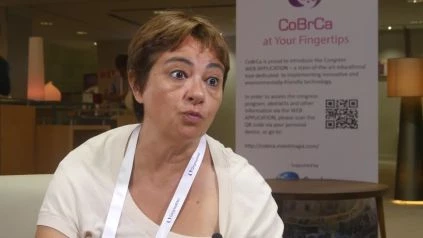Julia Camps Herrero, MD of the Hospital de la Ribera, Alzira, Spain, discusses the use of various methods for the detection of breast cancer at the 2016 World Congress on Controversies in Breast Cancer (CoBrCa), in Barcelona, Spain. She starts by explaining that mammography is not perfect. Up to 40% of cancers can be missed in very dense breasts. Other methods that are better than mammography have therefore been looked into. These are methods that do not need radiation, methods that do not need contrast, and methods that can look into breast density more effectively. One improved method is tomosynthesis; although it is also a form of radiation modality, it has the advantage of scanning the whole breast and reconstructing an image every 1mm. Therefore, the cancer can be seen straight away. Tomosynthesis has already been used in screenings, in perspective trials especially in Europe and also retrospective trials in the USA. The results have been very encouraging as not only does it detect 35% more of cancers, it also lowers the recall rate meaning it is more specific than mammography. Another method is ultrasound. Ultrasound for screening has 3 per 1000 detection rate. The problem with it, however, is that it is very time-consuming and has a very low positive predictive value, with many more false positives in ultrasound than in mammography. The third method is MRI. MRI is a method, which has been used to screen high risk patients, i.e. patients with a hereditary risk greater than 20%. MRI is advancing and an abbreviated method of MRI has been proposed. This would mean less time to carry out the MRI and less time to read it. Another method is diffusion MRI which is an MRI that does not need any contrast. Although the data at the moment is theoretical, it is very encouraging because it doesnt need contrast and isnt affected by breast density and does not hurt the patient in any way.
The use of various methods for the diagnonsis of breast cancer: tomosynthesis, ultrasound and MRI

